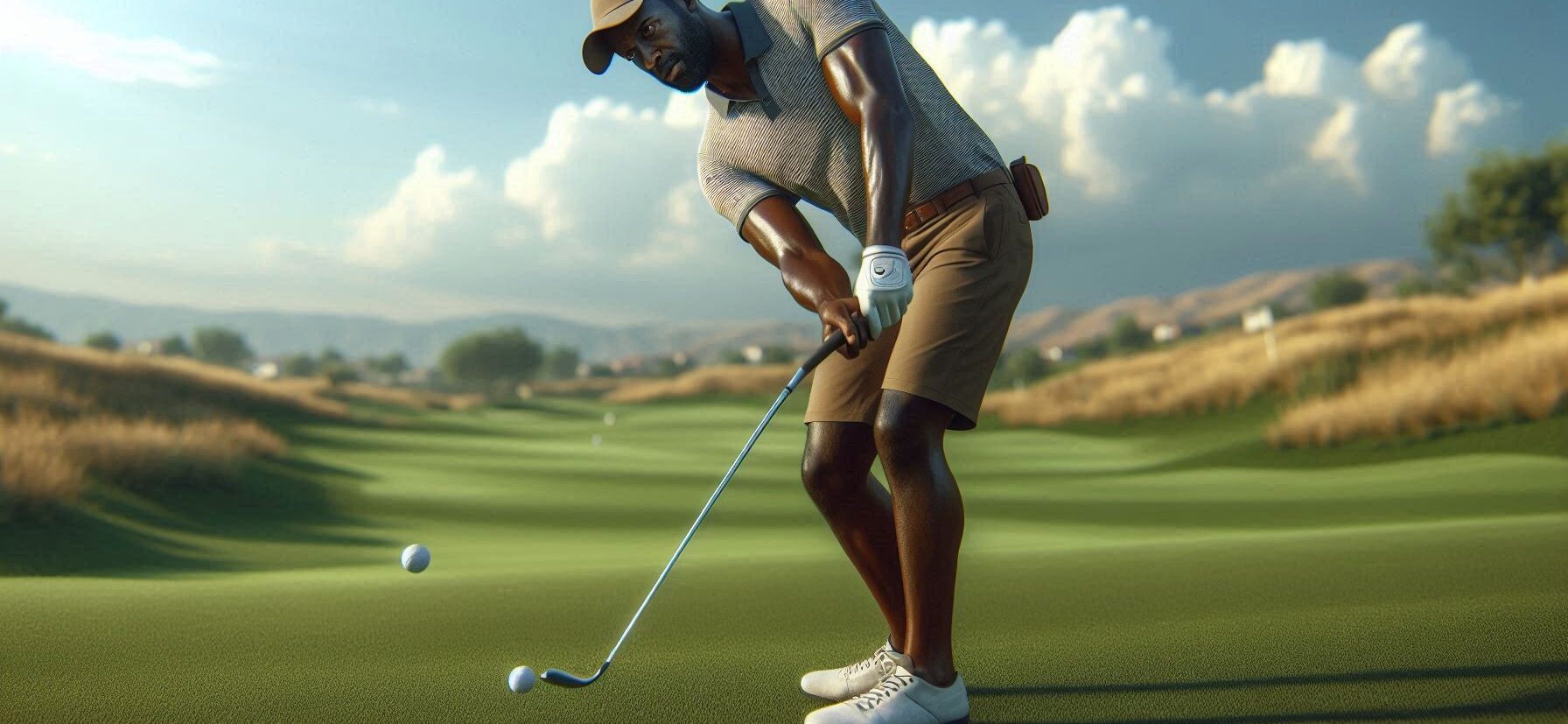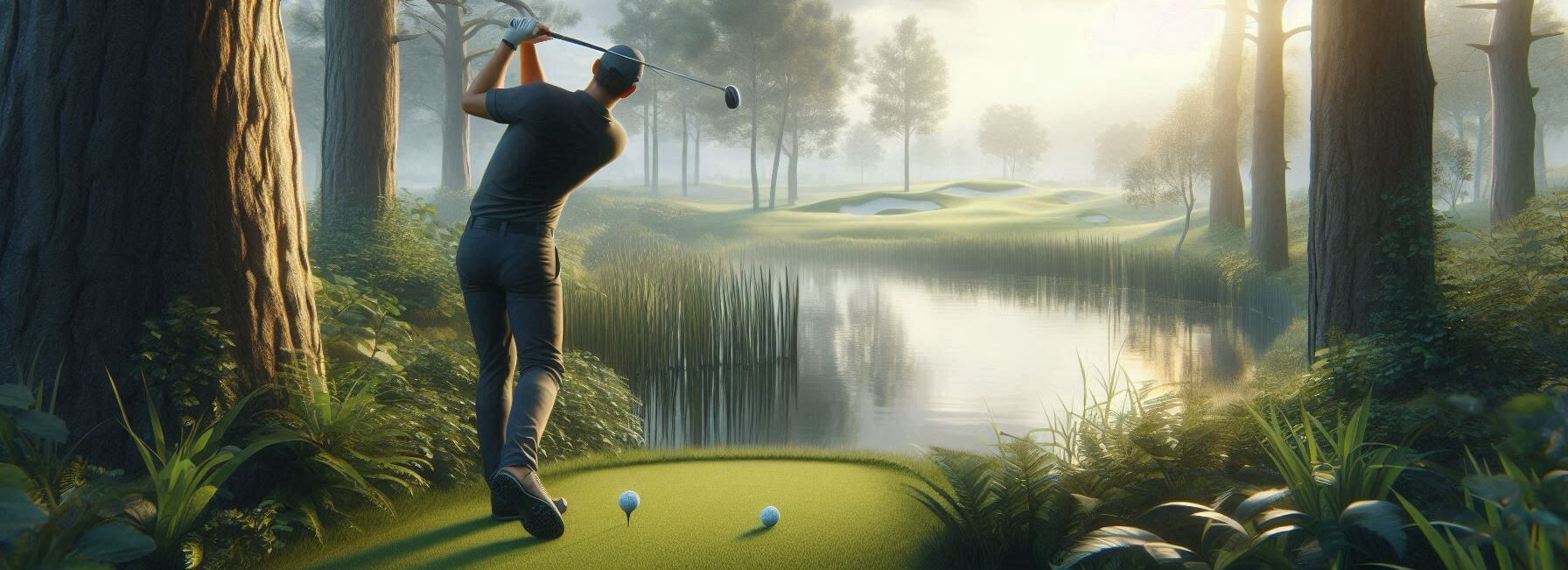Top Takeaways and Key Concepts
→ Refine your grip technique to ensure control, comfort, and consistent contact with every swing.
→ Establish a balanced stance with proper posture and ball placement for improved accuracy.
→ Perfect your swing mechanics by mastering smooth weight transfer and steady follow-through.
→ Strengthen your short game through focused chipping and putting practice sessions.
→ Maintain mental focus with visualization, calm breathing, and confidence during every round.
Summary of This Article
This article teaches golfers how grip, stance, and swing mechanics work together to improve control and consistency. It emphasizes the importance of short-game practice and mental focus for better performance. With steady breathing, visualization, and consistent drills, players can elevate their confidence, accuracy, and overall enjoyment on the golf course.
Video Summary
Please Note: This post may contain affiliate links. If you click one of them, we may receive a commission at no extra cost to you. As an Amazon Associate, I earn from qualifying purchases.
Golf is one of those sports that seems simple until you step onto the green and realize you’re not quite as good as you thought. I mean, who hasn’t felt like a total pro on the driving range only to slice their first shot into the nearest tree? But fear not! With some expert golfing tips, you can transform your game from “oops” to “wow!” Let’s dive into some advice that could help you hit those birdies and maybe even avoid the dreaded water hazards.
Understanding Your Grip

“The grip is the only connection you have to the club, so make sure it’s a good one.” – Jack Nicklaus
Let's talk about your grip first. It might sound small, but trust me, it's like trying to eat spaghetti with chopsticks if it's not correct. Everything else in your swing depends on how you hold the club. Think about holding a tube of toothpaste. You need to be able to handle it well enough to not squeeze out all the minty freshness. You should hold your club with exactly the right amount of pressure so that you feel safe but not tight.

Like how some people like their coffee black and others like it with milk and sugar, I've learned that various players favor different grips. The interlocking grip and the overlapping grip are the two most prevalent types. Try out a few different things and see which one feels better for you. Honestly, my shots got a lot more consistent after I finally changed my grip after years of being stubborn.
Did you know that the average golfer changes their grip style about 5 times before settling on one they feel comfortable with? It’s like dating—sometimes it takes a few tries to find the perfect match!
And while we're talking about consistency, always check your grip before you swing. It may sound foolish, but sometimes we get so caught up in our heads (or our friends' poor jokes) that we forget what we're doing with our hands. A short change can mean the difference between hitting a straight drive and blasting it off into space.
Mastering Your Stance

“Your stance is the foundation of your swing; if it’s not solid, nothing else will be.” – Ben Hogan
Now that you know how to hold the club, let's talk about posture. Looking good on the course isn't only about wearing stylish golf shoes! The way you stand can have a big effect on how balanced and powerful your swing is. You know how hard it is to lift a large box while standing on one leg? Not likely!
To get into a good posture, stand with your feet shoulder-width apart and bend your knees slightly. You want to feel stable but ready to act, like a cat preparing to pounce on a toy mouse that doesn't know it's there. Make sure your weight is evenly distributed; this will help you stay stable during your swing.
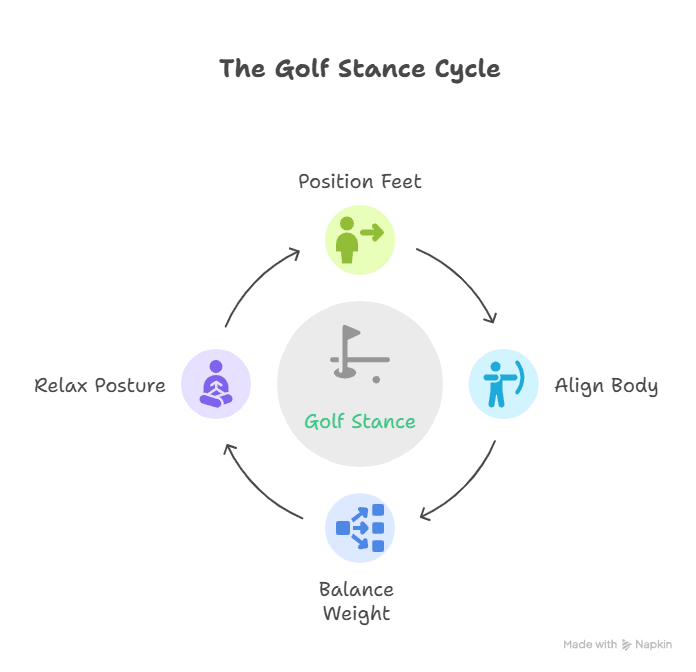
It's interesting that a lot of golfers don't think about how the ball is placed in relation to their stance. You might think that's not a big deal, but believe me, it can make the difference between a great drive and a frustrated shank that sends your ball into the next county! That little white ball's position can have a big impact on how you swing and how well you play on the course.
For example, when you use a driver, it's important to put the ball closer to your front foot. Why? This position lets you hit the ball at an angle as you swing through. If you were going to send a rocket into space, you wouldn't want to point it straight toward the ground first, would you? You need to go up! You may hit the ball farther and receive that lovely sound of strong contact through your club by putting it in front of you, usually around your left heel (for right-handed players).
When it comes to shorter clubs like irons or wedges, though, keeping the ball in the middle of your stance works great. Putting it this way helps make sure you hit the ball with a downward blow. You could say that you're giving yourself permission to dig into those greens instead of just floating over them. Consistency is really important when you take short shots. If you put the ball in the right place, you can hit it cleaner and have more control over where it goes.
Here’s a fun fact: The famous golfer Ben Hogan once said that the perfect stance is like a good pair of shoes—if it’s not comfortable, you’ll never play your best! So, if you find yourself wobbling on the course, just remember: even the pros had to break in their “golf shoes”!
Don't forget about those cunning falsehoods now! Moving your ball location a little bit can also aid if you're playing on an uneven surface or thick grass. For instance, if you're in deep rough or on an uphill lie with an iron, sliding it back a little in your stance may make it more stable when you hit the ball. It's all about being flexible and figuring out what works best for each situation. For example, use golf clubs instead of duct tape!
In short, being aware of where you put that small white ball can really improve your game. You have to practice and try different things to find what works for you while still getting results. But after you figure out these small details of setup and positioning, you'll wonder why you didn't pay more attention to them earlier! So, the next time you're on the course or at the driving range and your strokes are all over the place, take a second to check where you're putting the golf ball. Your future self will be grateful!
Perfecting Your Swing Mechanics

“The secret of golf is to turn three times: once in the backswing, once in the downswing, and once in the follow-through.” – Bobby Jones
Now we get to the swing, which is probably the most talked-about part of golf. It's a lot like making cookies: if you don't get the right amount of one ingredient or mix them together the wrong way, you'll end up with something completely different than what you wanted (and probably less tasty). So let's go over those mechanics step by step.
Start with a smooth takeaway. Imagine that you're softly pulling back a slingshot instead of ripping it back like you're attempting to start a lawnmower. As you pull the club back behind you, keep your arms relaxed and turn your shoulders away from the target while still looking at the sly little ball below.
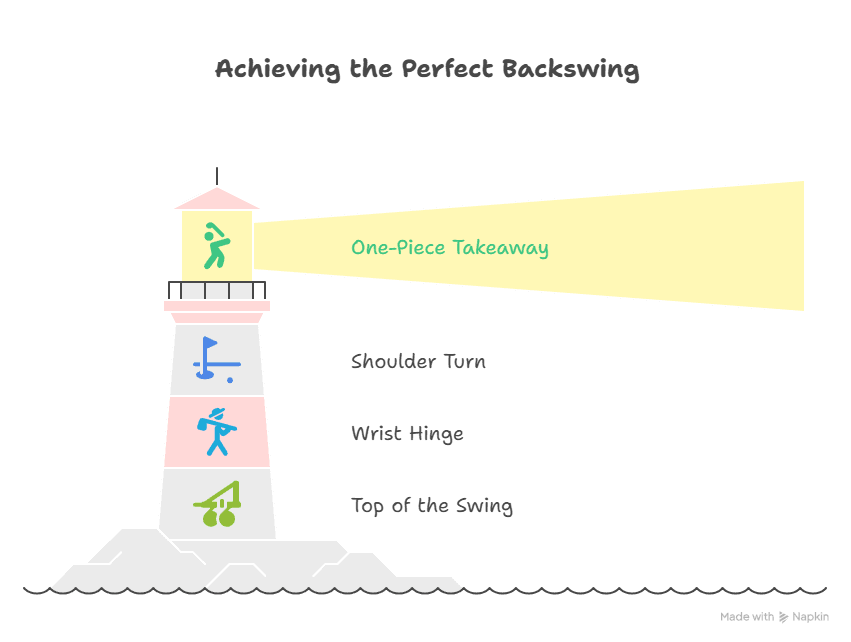
It's time to show off as you move into your downswing. This is the time when all of your hard work in practice pays off, so believe me when I say you want to do it right. The most important thing is to move your weight from your back foot to your front foot in a smooth and controlled way. If you speed through it, you'll step on toes (or worse, hit your golf ball into the trees). This smooth motion creates power without losing control, which is very important for striking clean shots.
I used to be that golfer who would almost jump into the downswing like I was leaping into a pool of freezing water—excited but totally out of control. I would think things like “This could be my best shot yet!” or “What if I slice it?” a lot. But to be honest, hurrying through this section always resulted to bad things happening. My ball would go off course faster than a squirrel running away from traffic! I was mad because I knew I could make better pictures; I simply needed to find the right balance.
Taking my time during this change has made a big difference. When you slow down and pay attention to how you're shifting your weight, you're giving your legs and core a chance to work out those massive muscles. This is where genuine strength comes from! Think of yourself like a coiled spring. When you put weight on your back foot, you're accumulating energy. Then, when it's time to let go of that energy by easily moving forward onto your front foot, bang! You let all that stored energy out in the shot.
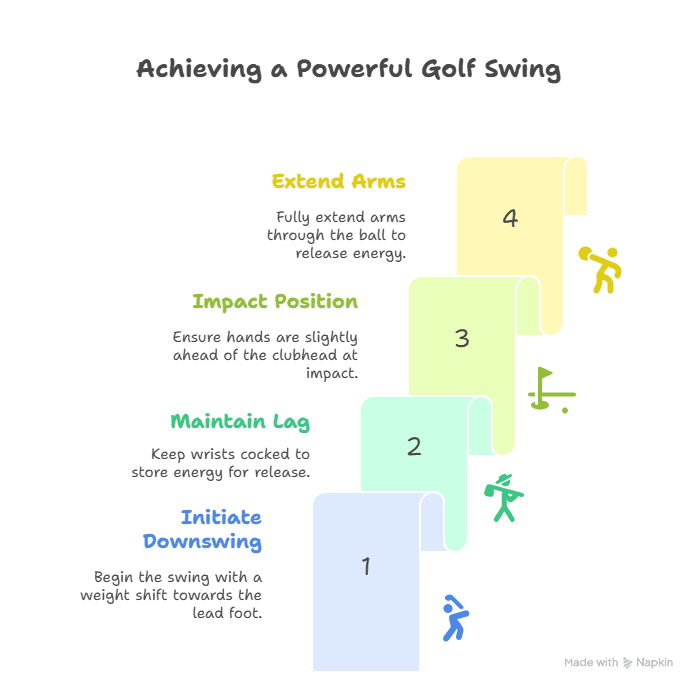
This smooth transfer is particularly interesting because it helps with consistency. If you don't speed through the motion, you're less likely to lose your balance or swing the wrong way. You'll keep a strong posture throughout the whole swing process instead of flailing around like an inflatable tube man at a car sale (you know what I mean). That means you can hit the ball more accurately and with more confidence.
One wonderful approach to practice this change is to do drills that only focus on changing your weight. For instance, you may try swinging while standing on one leg or utilizing alignment sticks that are set in the right spots on either side of you. These exercises can help you feel balanced and solid while also reinforcing the right way to move.
Did you know that the longest recorded golf swing is 12 feet? That’s right! In a quirky competition, a golfer named Mike Austin swung a club with such force that it sent his ball flying over 400 yards—while he was using a driver designed for seniors! So, while perfecting your swing mechanics, remember: sometimes it’s not just about technique; it’s also about having fun and embracing the unexpected!
It's not just about hitting harder as you go down; it's also about hitting intelligently! So the next time you're getting ready to hit the perfect shot, take a deep breath and remember that slow and steady wins the race (and keeps those golf balls flying straight). If you learn how to accomplish this part of your swing mechanics, you'll be able to hit the ball farther and more accurately. Who doesn't want that?
Lastly, the follow-through is important too! You know what I mean if you've ever seen someone complete their swing looking uncomfortably slumped over or falling forward like they tripped over an unseen rock. A high and balanced finish shows that you have the right technique and gives you the confidence of a golf champion.
Short Game Strategies
“Golf is a game of inches. The short game is where you can save strokes and lower your score.” — Phil Mickelson
Let's talk about short game strategies now, which are generally forgotten. You can save strokes faster by learning how to chip and putt than by finding out that dessert is on the menu for supper. A lot of golfers spend a lot of time working on their drives but completely ignore these important parts.
Instead of using overwhelming force, chipping needs subtlety. Think of it as a gentle touch instead of going full Hulk mode. Try different types of lays around the greens. Different types of grass make different kinds of problems. Also, discover how much roll-out each chip gives you based on the club you use and the angle you hit it.
At first appearance, putting may seem easy, like a walk in the park, but don't be fooled! It takes a lot of careful observation, like Sherlock Holmes looking at clues left behind by wayward golf balls. If you don't pay attention to the small details of the green, you might as well be trying to solve a mystery without any clues. It's completely confusing!
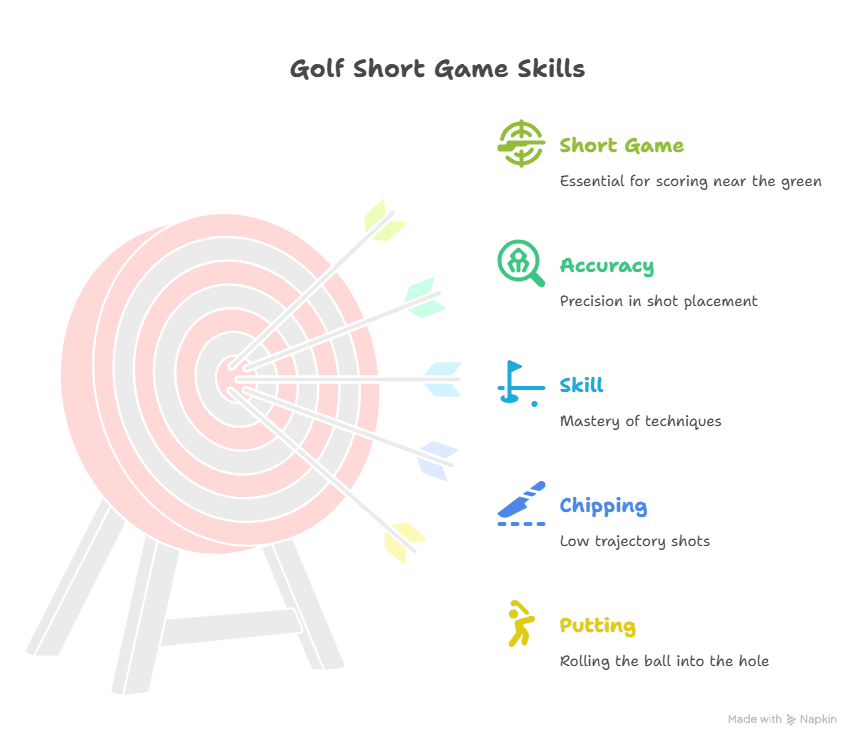
First things first, pay attention to the slopes on the greens. They can be sneakier than a thief in a dark alley. A small rise or fall here or there might make a big difference in how your ball rolls. You might believe you're ready for an easy putt, but then your ball goes off course like it's trying out for a part in “The Great Golf Ball Escape.” So pay close attention! Go around the hole and look at it from different angles. Is that side a little higher up? Does it go down to the right? These details are really important.
Now let's talk about gravity, the old acquaintance we learnt about in school. Do you remember how it changes speed? A putt that goes downhill rolls faster than one that goes upwards. Who would have thought that physics could be useful in free time? When you have to putt downhill, it feels like gravity is helping your ball get to the hole. When you have to hit an uphill putt, on the other hand, you'll have to push that little white ball forward with precisely the right amount of force to get it to move. This means you need to change your aim and power. If you don't, you can end up cursing under your breath as your ball stops just short of glory.
Reading greens is almost like an art form; it takes a lot of practice and patience. Think about how the water would flow over the surface if it rained. Where would the puddles be? Which way would they go? This mental practice might help you guess what your ball will do after it leaves the face of your putter.
When putting on Bermuda grass, don't forget about the direction of the grain! A lot of golfers don't realize that this adds another level of difficulty. The way the grass grows depends on how much sunshine it gets. If you're putting against the grain, expect it to be harder and change your stroke appropriately. If you're lucky enough to have greens cut with the grain going the way you want your shot to go, then my friend, that's a gift from nature!
One last piece of advice: believe in yourself and go through with each stroke! If you hesitate on the green, you might end up in a lot of trouble. It's like second-guessing whether or not you locked your front door when you left the house; anxiousness usually leads us wrong! Instead of second-guessing yourself in the middle of a swing (which can lead to those awful “yips”), think about what you've practiced.
Here’s a humorous fact: The average golfer spends about 70% of their strokes on the short game, yet many treat it like that awkward family member at a reunion—avoiding it as much as possible! Remember, mastering your chipping and putting can save you more strokes than trying to drive the ball 300 yards. So next time you’re at the course, give your short game some love—it might just appreciate the attention!
Putting may seem easy at first, like ordering coffee, but you need to think about a lot of things before you make that perfect stroke into the hole. If you use your observational skills and learn to accept the oddities of physics and nature, as well as trust yourself every time you try, you'll soon realize that placing is less of a mystery and more like riding a bike (without falling off!). Get your clubs and get ready to do some serious green detective work!
To be fair, even experienced players sometimes miss easy putts because they forget the basics when they're under pressure (I know I do!). That's why it's worth it to set aside time to practice putting drills just for that purpose.
Staying Mentally Strong
“Golf is a game of confidence. If you don’t believe in yourself, no one else will.” — Jack Nicklaus
Finally, and maybe most significantly, you need to stay mentally strong during every round since golf is as much a cerebral game as it is a physical one. Have you ever had one terrible hole derail a game that was going well? Yeah, me too!
Before each shot, make a plan. Take deep breaths or picture yourself succeeding. This will help you stay calm and focused on good things instead of negative things that happen unexpectedly.
Having friends who support you during rounds is also very important. They will cheer you on when things go well and give you encouragement when things get tough, even if they are also having trouble. Keep in mind that everyone has difficult days. Learning to be strong will help you get better over time instead of only thinking about the unpleasant things.
Featured Snippet: To improve your golf game, focus on mastering grip, stance, and swing mechanics. Practice your short game with chipping and putting drills, and build mental focus through visualization and calm breathing. With consistent practice and patience, you can play with greater accuracy, confidence, and control on the course.
Frequently Asked Questions
What is the most important skill for improving my golf game?
Mastering your grip and stance is the foundation for every great shot. A proper grip and balanced posture lead to better control, accuracy, and swing consistency.
How can I fix my golf swing for more consistent shots?
Focus on smooth weight transfer, relaxed shoulders, and steady rhythm. Avoid rushing your downswing and maintain balance throughout the motion for consistent ball contact.
Why is practicing the short game so important?
The short game—chipping and putting—makes up most strokes in a round. Improving these skills helps lower your score faster than focusing solely on long drives.
How tight should my grip be when holding the golf club?
Hold the club firmly but not tensely—like gripping a tube of toothpaste without squeezing it. Too much tension limits flexibility and accuracy.
What’s the best way to stay mentally strong during a round?
Use visualization, deep breathing, and positive self-talk before each shot. Focusing on one swing at a time keeps your confidence steady and reduces frustration.
How can I read greens more effectively when putting?
Observe the slopes, grain, and speed of the green. Imagine how water would flow across it to visualize the correct line and pace for your putt.
How often should I practice golf to see real improvement?
Consistent weekly practice focused on grip, swing mechanics, and short game drills leads to steady progress and improved performance over time.
Suggested Resources
“10 Tips for Better Golf”
https://www.golfdigest.com/story/10-tips-for-better-golf
“The Importance of Grip in Golf”
https://www.golf.com/instruction/grip-importance-in-golf/
“Mastering Your Short Game”
https://www.golflink.com/golf-tips/short-game-mastery

Kevin Collier is an avid golfer and contributing author at AIGolfTips.com, where he shares his passion for the game through expert tips, techniques, and gear reviews. With years of experience on the course, Kevin offers valuable insights for golfers of all skill levels, helping them improve their game and maximize their potential. Whether discussing swing mechanics or the latest in golf technology, Kevin's engaging approach aims to inspire and educate fellow golf enthusiasts to elevate their performance and enjoy every moment on the green.



